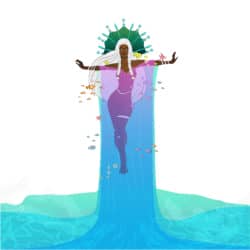 Ceto, also spelled Keto and translated as “sea monster,” is the daughter of Pontus and Gaia in Greek mythology. She is the primordial goddess of sea monsters and large sea creatures such as sharks and whales. Most notably, Ceto is known for bearing truly horrid creatures with her brother Phorcys. Here’s more information about this sea goddess:
Ceto, also spelled Keto and translated as “sea monster,” is the daughter of Pontus and Gaia in Greek mythology. She is the primordial goddess of sea monsters and large sea creatures such as sharks and whales. Most notably, Ceto is known for bearing truly horrid creatures with her brother Phorcys. Here’s more information about this sea goddess:
Ceto Goes By Other Names
Ceto is also known in some Greek texts as Crataeis, which means “mighty,” and as Trienus, which means “within three years.” Some scholars blended her with the goddess of Hectate, whose nicknames are also Crataeis and Trienus.
However, don’t get her confused with the minor Oceanid of the same name: She is one of 3,000 sea nymphs born of Tethys and Oceanus. Additionally, the ancient Greek word for “sea monster” is “ketos”, which is how her name could have derived.
Ceto’s Family Tree
Greek mythology can be a little confusing when it comes to families. Below are short descriptions of Pontus, Gaia, Phorcys and Ceto’s children as listed in Hesiod’s work, Theogony. This list of children is the most consistent across sources.
- Pontus – As the primordial god of the sea, he is the consort of Gaia and the father of Ceto. He created all sea creatures and spirits, and every sea god is his descendant.
- Gaia – As the primordial Mother Earth goddess, she is the ancestral mother of all life and the mother of Ceto. She was also consort to her son Uranus, the primordial god of the sky, with whom she bore the Giants and the Titans.
- Phorcys – As the son of Pontus and Gaia, he is the god of the hidden dangers of the deep sea.
- Echidna – As a daughter of Ceto and Phorcys, she is half woman, half snake: a monstrous sea dragon.
- Gorgons – Ceto and Phorcys’ three daughters Euryale, Medusa and Stheno are known as the Gorgons, whose petrifying gaze is believed to have created the rocks and reefs in the sea.
- Graeae – As servants to their Gorgon sisters, these three daughters are the personification of kind, vulnerable old age. Later, however, Dino, Enyo and Pephredo became regarded as decrepit women with only one tooth, one eye and one gray wig that they shared.
- Ladon – As the son of Ceto and Phorcys, he is a hundred-headed sea serpent who guarded the golden apples in the Garden of the Hesperides. In some sources, however, he is known as the son of Echidna and Typhon, making him Ceto’s grandson.
Ceto Had Other Offspring
According to some other sources, Ceto possibly had other children. A commentator on Apollonius Rhodius notes that Hesperides are the daughters of Ceto and Phorcys, but this isn’t consistent in other sources. The Hesperides are the nymphs of evening and the golden light of the sunset.
The author Homer notes Thoosa as the daughter of Phorcys, but doesn’t mention if Ceto is her mother. Thoosa is a sea nymph and the mother of Polyphemus, a cyclops, by Poseidon.
Ceto in Popular Culture
In “The Mark of Athena” by Rick Riordan, Ceto and Phorcys operate an aquarium that features exhibitions by sea monsters and mythological underwater creatures. Phorcys imprisons Frank Zhang and Percy Jackson, descendants of Poseidon. The satyr Coach Gleeson Hedge rescues them, kicking Ceto in the head. Angry about his, the sea goddess sends a Skolopendra to attack their ship. However, the Ichthyocentaurs had vowed to conquer Ceto and Phorcys, which defeated the Skolopendra.
As you can see, Ceto isn’t exactly the most well known of the Greek goddesses. However, is very much a part of Greek mythology.

